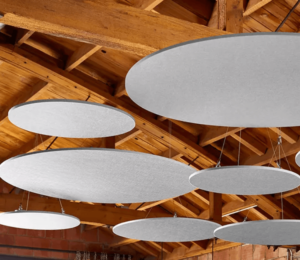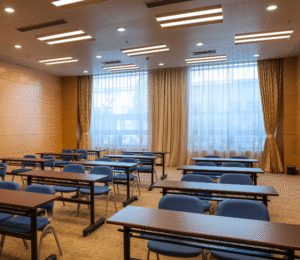Generator rooms are essential for providing backup power in residential, commercial, and industrial settings. However, they are also notorious for being noisy, which can lead to discomfort, health issues, and even regulatory violations. Proper acoustic management in generator rooms is crucial to mitigate noise pollution and ensure a safe, comfortable environment. In this blog, we’ll explore everything you need to know about acoustics in generator rooms, including the sources of noise, the challenges involved, and effective solutions to control and reduce noise levels.
Table of Contents
Why Acoustics Matter in Generator Rooms
Generators produce significant noise due to the mechanical and combustion processes involved in power generation. This noise can have several negative impacts:
- Health Risks: Prolonged exposure to high noise levels can lead to hearing loss, stress, and other health issues.
- Regulatory Compliance: Many regions have strict noise regulations that must be adhered to, especially in residential and commercial areas.
- Operational Efficiency: Excessive noise can interfere with communication and reduce productivity in nearby workspaces.
- Environmental Impact: Noise pollution can disturb surrounding communities and wildlife.
By addressing the acoustics in generator rooms, you can create a safer, more compliant, and efficient environment.
Sources of Noise in Generator Rooms
To effectively manage noise in a generator room, it’s important to understand the primary sources of noise:
1. Engine Noise
- The internal combustion engine is the main source of noise in a generator. This includes noise from the exhaust, intake, and mechanical components like pistons and valves.
2. Cooling Fans
- Generators require cooling systems, and the fans used in these systems can produce significant noise, especially at high speeds.
3. Alternator Noise
- The alternator, which converts mechanical energy into electrical energy, can produce electromagnetic and mechanical noise.
4. Vibration and Structure-Borne Noise
- Vibrations from the generator can travel through the floor, walls, and other structures, creating additional noise.
5. Exhaust System
- The exhaust system, which expels combustion gases, can produce loud noise if not properly designed or insulated.
Challenges in Managing Generator Room Acoustics
Managing noise in generator rooms presents several challenges:
- High Noise Levels: Generators can produce noise levels exceeding 100 decibels (dB), which is well above safe limits.
- Low-Frequency Noise: Much of the noise from generators is low-frequency, which is harder to block or absorb compared to high-frequency noise.
- Heat Dissipation: Generators produce a lot of heat, and any acoustic treatment must allow for proper ventilation and cooling.
- Space Constraints: Generator rooms are often small and crowded, making it difficult to install acoustic solutions without interfering with operations.
Effective Acoustic Solutions for Generator Rooms
To address these challenges, a combination of soundproofing and noise control techniques is required. Here are some of the most effective solutions:
1. Soundproof Enclosures
- Generator Enclosures: Custom-built enclosures made from soundproof materials like mass-loaded vinyl (MLV), acoustic foam, and plywood can significantly reduce noise levels. These enclosures are designed to fit around the generator while allowing for proper ventilation.
- Modular Enclosures: Prefabricated modular enclosures are a cost-effective option for smaller generators. They are easy to install and can be customized to meet specific noise reduction requirements.
2. Acoustic Panels and Wall Treatments
- Wall-Mounted Panels: Installing acoustic panels on the walls of the generator room can absorb sound waves and reduce reverberation.
- Soundproof Drywall: Adding an extra layer of soundproof drywall to the walls can improve sound insulation.
- Resilient Channels: These are used to decouple the walls from the structure, reducing the transmission of vibrations.
3. Vibration Isolation
- Anti-Vibration Mounts: Placing the generator on anti-vibration mounts can prevent vibrations from traveling through the floor and walls.
- Floating Floors: A floating floor system, which isolates the generator from the building structure, can further reduce structure-borne noise.
4. Exhaust Silencers
- Mufflers: Installing high-quality mufflers on the exhaust system can significantly reduce exhaust noise.
- Flexible Exhaust Connectors: These connectors absorb vibrations and prevent them from traveling through the exhaust system.
5. Ventilation and Acoustic Louvers
- Acoustic Louvers: These are specially designed to allow airflow while blocking noise. They are ideal for maintaining ventilation in soundproof enclosures.
- Duct Silencers: Installing silencers in the ventilation ducts can reduce noise from cooling fans and other airflow systems.
6. Door and Window Sealing
- Soundproof Doors: Heavy, insulated doors with airtight seals can prevent noise from escaping the generator room.
- Acoustic Windows: If the generator room has windows, replacing them with acoustic-grade windows can help block noise.
7. Noise Barriers
- Outdoor Barriers: For generator rooms located outdoors, noise barriers made from materials like concrete or acoustic fencing can block noise from reaching nearby areas.
Steps to Design an Acoustic Generator Room
Here’s a step-by-step guide to designing an acoustically optimized generator room:
- Assess Noise Levels: Measure the noise levels in and around the generator room to identify problem areas.
- Choose the Right Location: If possible, place the generator room away from sensitive areas like offices or residential spaces.
- Install Soundproof Enclosures: Use enclosures to contain the generator noise.
- Treat Walls and Ceilings: Add acoustic panels, soundproof drywall, or resilient channels to walls and ceilings.
- Isolate Vibrations: Use anti-vibration mounts and floating floors to reduce structure-borne noise.
- Upgrade Exhaust Systems: Install mufflers and flexible connectors to minimize exhaust noise.
- Ensure Proper Ventilation: Use acoustic louvers and duct silencers to maintain airflow while reducing noise.
- Seal Gaps: Install soundproof doors and windows, and seal any gaps or cracks in the room.
Compliance with Noise Regulations
When designing an acoustic generator room, it’s essential to comply with local noise regulations. These regulations typically specify maximum permissible noise levels in decibels (dB) for different times of the day and types of areas (residential, commercial, industrial). Work with an acoustic consultant to ensure your generator room meets these requirements.
At Gitco-SA, we specialize in providing tailored acoustic solutions for generator rooms and other challenging environments. From soundproof enclosures to vibration isolation systems, our team of experts is here to help you achieve optimal noise control.
Let’s work together to silence the noise and power your world with peace and efficiency!



